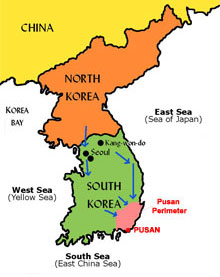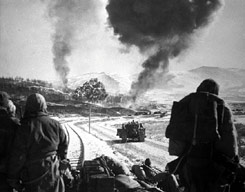 The Marine Corps continued its tradition of forward-looking innovation after World War II —much of this accomplished in the face of post-war demobilization and mandatory reduction in forces. President Truman and Defense Secretary Louis Johnson took an axe to all the military services. In the Marine Corps, a reduction of infantry regiments to two battalions, rather than the standard three. Instead of three rifle companies per battalion, there were only two. Instead of three infantry platoons per rifle company, there were only two. Thus, in June 1950 when communist North Korea invaded South Korea, the United States was barely able to respond. The problem facing most military units was not simply a matter of post-war manpower reductions —it was also a matter of inadequate training and poor leadership at the junior officer and mid-range NCO levels. Such conditions nearly handed the United States a disastrous defeat. At this time, the Marine Corps was fortunate, since most of its company grade officers and NCOs were combat veterans of World War II. They might have operated with fewer rifle platoons and aircraft, but they knew what they had to do.
The Marine Corps continued its tradition of forward-looking innovation after World War II —much of this accomplished in the face of post-war demobilization and mandatory reduction in forces. President Truman and Defense Secretary Louis Johnson took an axe to all the military services. In the Marine Corps, a reduction of infantry regiments to two battalions, rather than the standard three. Instead of three rifle companies per battalion, there were only two. Instead of three infantry platoons per rifle company, there were only two. Thus, in June 1950 when communist North Korea invaded South Korea, the United States was barely able to respond. The problem facing most military units was not simply a matter of post-war manpower reductions —it was also a matter of inadequate training and poor leadership at the junior officer and mid-range NCO levels. Such conditions nearly handed the United States a disastrous defeat. At this time, the Marine Corps was fortunate, since most of its company grade officers and NCOs were combat veterans of World War II. They might have operated with fewer rifle platoons and aircraft, but they knew what they had to do.
Pushed all the way to the southern tip of the Korean Peninsula, the Eighth US Army was barely able to hold on to the area of Pusan against a highly aggressive, well trained, and well-equipped North Korean army. In only five weeks from the North Korean invasion, the First Provisional Marine Corps brigade arrived in Pusan —the last remaining port available to United Nations forces. The brigade deployed as an integrated air-ground team —as it had been envisioned in 1933. A reconstituted 5th Marine Regiment paired with Marine Aircraft Group-33 (consisting of two Corsair squadrons, one night-fighter squadron, and a light observation squadron with four Sikorsky helicopters). The Brigade, known as the Fire Brigade, operated under the command of Brigadier General Edward A. Craig, a seasoned combat leader. The first thing Marines did after their arrival in Pusan was go into the attack.
MAG-33 flew close air support missions from escort carriers on station in the Sea of Japan. The combined firepower of American infantry and ground attack aircraft proved decisive in a number of clashes with tank-led North Korean forces along the Naktong River. These small-scale tactical victories raised the morale of front line forces and bought much needed time to develop an aggressive strategy. In September, the balance of the 1st Marine Division arrived in Korea, absorbed the Fire Brigade, and sailed into the Yellow Sea as the point of General MacArthur’s spear at Inchon. The hard work finally paid off and now everyone knew that the Marine Corps air-ground team packed a lethal punch.
 The Korean War reunited the 1st Marine Divison and 1st Marine Aircraft Wing for the first time since Guadalcanal; never before was there a time when Marine Corps close air support was more badly needed, or more responsively provided than in the 90-day period between the Inchon landing and the breakout from the Chosin Reservoir. Marine F4U Corsairs launched their attacks from escort carriers and expeditionary airfields, supporting battalions from Wolmi-do Island, across the Han River, and into the urban setting of Seoul —South Korea’s capital city. The North Koreans threw up one barricade after another to stop the advance of Marine infantry units, but none of these survived the assault of Marine Corsairs.
The Korean War reunited the 1st Marine Divison and 1st Marine Aircraft Wing for the first time since Guadalcanal; never before was there a time when Marine Corps close air support was more badly needed, or more responsively provided than in the 90-day period between the Inchon landing and the breakout from the Chosin Reservoir. Marine F4U Corsairs launched their attacks from escort carriers and expeditionary airfields, supporting battalions from Wolmi-do Island, across the Han River, and into the urban setting of Seoul —South Korea’s capital city. The North Koreans threw up one barricade after another to stop the advance of Marine infantry units, but none of these survived the assault of Marine Corsairs.
Later, as Marine infantry fought to extricate themselves from ten Chinese divisions trying to annihilate them, during the coldest winter in memory around the Chosin Reservoir, Marine aircraft remained on station overhead during every daylight hour. At the conclusion of the Chosin Reservoir campaign, the Commanding General of the 1st Marine Division, Major General Oliver P. Smith commended Marine pilots: “Never in its history has Marine aviation given more proof of its indispensible value to ground Marines. A bond of understanding has been established here that will never be broken.”
We define Close Air Support (CAS) as an air action by fixed and rotary wing aircraft, directed against hostile targets in close proximity to friendly forces. Marine Corps aviation is organized and equipped today to perform its primary function of assault, support, anti-aircraft warfare, offensive air support, electronic warfare, control of aircraft and missiles, and expeditionary reconnaissance. These things are inherently dangerous to pilots and grunts alike. There is nothing simple about air-ground coordination, or of placing needed ordnance on target, on time. These skill sets take years of constant training to achieve. Marine riflemen take a keen interest in the proximity of close air. To Marines, close air support means one thing: damn close.

Damn close, damn good. Excellent post.
LikeLike
Thank you for that.
LikeLiked by 1 person
I really enjoyed this series Mustang. I’m always amazed at what these guys can do.
LikeLike
I agree w/ Kid- this historical series is awesome–
and-you know-M- how much I love planes —
C-CS
LikeLike
More to come, CS … thank you.
LikeLike
have u seen American Sniper yet???
LikeLike
Not yet, Angel. I try not to make the buffoons in Hollywood richer, although I am sure I will see the film at some point.
LikeLike
This is a great series, Mustang. And all this before GPS! Much has been made of ‘friendly fire’ casualties. While no one accepts laziness and incompetence, the wonder is such losses aren’t more common in these situations, and are indeed part of the cost of winning. We who have not been there now appreciate this more from your writings.
OLD SUBJECT. This is related to a much older post, but I am reminded of it here, and that old post is closed now anyway. You recommended Bing West’s book The Village last fall. I tried to post a thank-you a few weeks ago, but it didn’t work. This reminded me of many scenes in that book, on the ground, coordinating air and artillery support. I just wanted you to know how much I learned from this book, which puts caricatures of the war into ordinary flesh-and-blood people we can identify with and the complexity of competing loyalties, interests and survival needs. I had so many “now I understand” moments. Mr. B is now reading it. So thanks for writing it up.
LikeLike
Thank you, Baysider. I very much appreciate your interest in this blog and your comments.
Bing West is an excellent writer. The impact those Marines made on the villagers continue even today.
LikeLike
Baysider… ” We who have not been there now appreciate this more from your writings. ”
True that Mustang, true that.
LikeLike
Thank you, my friend.
LikeLike